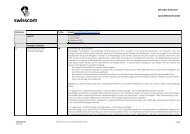Shareholders' Letter
Shareholders' Letter
Shareholders' Letter
You also want an ePaper? Increase the reach of your titles
YUMPU automatically turns print PDFs into web optimized ePapers that Google loves.
Transformation in the telecommunications market in the direction of the TIME industry, coupled<br />
with growing competition from OTT providers (Over The Top: Apple, Google, etc.), is giving rise to<br />
a transformation risk. This type of risk can be mitigated using measures such as restructuring, the<br />
adoption of new business models or the launch of efficiency-enhancing initiatives. The latest<br />
trends are driving the integration of technologies and devices for the provisioning of multimedia<br />
services. Risks could arise in connection with integration of the infrastructure in question, as well<br />
as in the interaction with and at the interfaces to the existing infrastructure. The occurrence of<br />
such risks could delay implementation of the growth strategy or lead to a drop in customer satisfaction.<br />
Transformation in the telecommunications market is generating correlated risks in the<br />
areas of corporate culture, personnel management and new business models. Swisscom is implementing<br />
a transformation programme focused on culture, structure, processes and human capital.<br />
Furthermore, OTT providers are driving change to such an extent that Swisscom – and the telecommunications<br />
sector in general – could be forced into the role of a bit-pipe operator (network infrastructure<br />
company). This situation is compounding the pressure to change and transform.<br />
Business interruption<br />
Swisscom’s business is heavily dependent on technical infrastructure such as communications<br />
networks and IT platforms. Any major disruption to business operations poses a financial as well<br />
as a reputation risk. In these areas force majeure, human error, hardware or software crashes or<br />
criminal actions by third parties (e.g. computer viruses) could cause damage or interrupt operations.<br />
Disruption could also harm the company’s high-quality image, customer loyalty or its ability<br />
to meet financial targets. To mitigate this risk, Swisscom developed a business continuity standard<br />
which was implemented in the Group companies. A business continuity management programme<br />
ensures that all key infrastructures, IT systems and processes are disclosed using a suitable valueat-risk<br />
approach, backed by contingency plans. Another risk concerns infrastructure obsolescence,<br />
accelerated by changes in technology. Swisscom’s current IT landscape is highly complex as a result<br />
of ongoing further development of older systems and integration of new systems. Lack of a harmonised<br />
IT landscape could hinder Swisscom from enhancing its competitive capability and<br />
exploiting further potential for cost savings.<br />
Fibre-optic expansion<br />
The fibre-optic expansion project (Fibre To The Home/Fibre To The Office, FTTx) entails high levels<br />
of investment over a number of years, and correspondingly high project-related risks, investment<br />
uncertainty and risks regarding the implementation strategy. Added to this, the project carries<br />
high regulatory and political risks. Swisscom has adopted a proactive risk management approach<br />
in the area of FTTx by pursuing a multi-fibre strategy and offering cooperation models. Besides<br />
inherent project risks and the aforementioned risks, risks exist in the following categories: infrastructure<br />
competition, partnerships, technology development (substitution risk) and solution<br />
design.<br />
The planned auctioning of mobile frequency licences in 2011 may harbour risks relating to licence<br />
costs and targeted network quality.<br />
Reputation risk management<br />
Swisscom’s reputation, including its quality image, allows it to differentiate itself from the competition.<br />
Swisscom monitors risks which could have a negative bearing on its reputation, image<br />
and brand. Risks which could tarnish its reputation are analysed and addressed on an ongoing<br />
basis using suitable communication and risk-mitigating measures. Reputation risk management<br />
falls under the responsibility of the Communications department and complements quantitative<br />
risk management. To this end, potential issues in the Swisscom Group are raised, assessed,<br />
analysed and corresponding measures are defined. Key reputation risks are reviewed at least once<br />
quarterly and the results incorporated in the Group risk report.<br />
IT and security risks<br />
Swisscom’s highly complex IT architecture means that replacing TDM technology with all-IP technology<br />
entails high risks during both the implementation and operating phases. These risks are<br />
also linked to other current risks such as human capital, transformation and cost savings.



